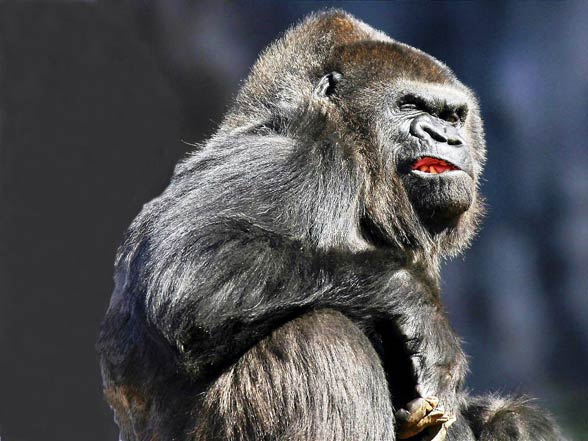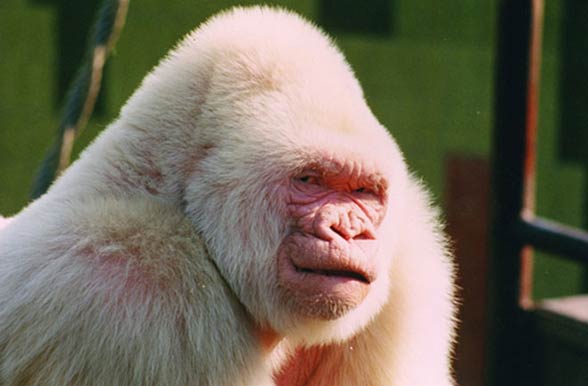Gorillas (Gorilla)
They are the kings of the jungle and of the mountains of the Democratic Republic of the Congo. Nevertheless, they do not stay out of the view of their subordinates, because they live with them in communities, and are not afraid to lose their lives in the name of protection. Although we have already described gorillas, we wanted to present more facts about their habits, skills and… feelings.
Classification
- Class: Mammalia
- Order: Primates
- Family: Hominidae
- Genus: Gorilla
Within the genus, two species, which include 4-5 subspecies have been classified:
- Western gorilla (Gorilla gorilla)
- subspecies: Western lowland gorilla (Gorilla gorilla gorilla)
- subspecies: Cross River gorilla (Gorilla gorilla diehli)
- Eastern gorilla (Gorilla beringei)
- subspecies: Mountain gorilla (Gorilla beringei beringei)
- subspecies: Eastern lowland gorilla (Gorilla beringei graueri)

Occurrence
The population is quite fragmented as both species are separated from each other by the Congo River and its tributaries.
The western gorilla occurs in Central Africa, while the eastern species occupies the central-eastern part of the continent. Depending on the species and subspecies, animals occupy different types of habitats at different heights – from mountain forests to swamps.
The eastern gorilla occurs in mountain and submontane forests at heights between 650 – 4000 m (0.4 – 2.5 mi) above the level of the sea. Mountain gorillas, as the name implies, select areas located higher, while the lowland eastern species like mountain bamboo forests and forest formations at altitudes between 600 – 3308 m (0.37 – 2.06 mi).
Western gorillas occur in lowland marshes and mountain forests at altitudes up to 1,600 m (0.99 mi). The western lowland gorilla also prefers marshes and lowland forests located at a maximum altitude of 1600 m (0.99 mi). The giant Gorilla gorilla diehli inhabit lowland and mountain forests at altitude 150-1600 m (0.09 – 0.99 mi)

Appearance
All gorillas are moving on four limbs, using their wrists. They take upright posture only occasionally when they have to carry the food or protect themselves against the attacker.
Wild males weigh from 135 to 180 kg (298 – 397 lb), while adult females can only reach half the total weight of males – from 68 to 113 kg (150 – 249 lb). Males are 1.7 to 1.8 m (5.6 – 6 ft) tall with a shoulder span of 2.3 to 2.6 m (7.5 – 8.5 ft), females are much lower, and their arms are shorter.
The jaw system is described as prognathic (the mandible protrudes farther out than the maxilla). Down through the tip of an adult male’s skull goes a so-called sagittal crest (a ridge of bone running lengthwise along the midline of the top of the skull).
Eastern gorillas are darker than their western relatives; the mountain gorilla is the darkest and at the same time have the thickest fur.
Lowland specimens have a slimmer silhouette, are more agile than heavy mountain gorillas. The eastern species has a longer face and a broader chest in comparison to the western species.
The gorilla’s senses act very much like the humans’, including sight, hearing, touch, taste and smell.
Although the gorilla’s sight is not as good as that of a human, it can distinguish colors.

Diet and searching for food
Gorilla has a very carefully arranged daily schedule: it rests, travels and eats at a specific time. The menu varies within species and subspecies.
Mountain gorillas eat mostly leaves, stems, and shoots. Fruit is a small part of its diet. Because the food supply is abundant, the herds do not have to compete with each other over it. The area of its territory ranges from 3 to 15 km2, and during the day the group moves forward about 500 m or less. Although gorillas eat only a few plant species, they can modify their diet and live in different habitats.
Eastern lowland gorillas have a very rich menu, depending on the seasons; leaves and crumbs are eaten most often, but fruit can account for up to 25% of the total diet. However, since the fruit is quite rare, the gorillas must travel each day further and further (the area of its territory ranges from 2.7 to 6.5 km2), therefore within 24 hours, they cover the distance from 154 to 2280 meters. They enrich their diet with insects, especially ants.
The lowland species eats a lot of fruit, and the herds are more dispersed than it is in the case of the rest of the species. In addition to that, they travel further distances comparing to other subspecies – they cover on average 1105 meters per day and their territory span ranges from 7 to 14 km2. The lowland western species have less access to land herbs, therefore it can switch to water plants if the environment allows it. Apart from ants, they can also eat termites.

Do the gorillas drink water?
Gorillas rarely drink water because they consume juicy plants, which consist of about 50% of water. They also like to drink morning dew, however, they were observed several times to have been drinking water straight from a water body.
Gorillas’ enemies
Their biggest natural enemy is the leopard (Panthera pardus). The naturalists have been finding the remains of a gorilla in leopard’s feces, although it is possible that the predator had eaten an already dead gorilla.
When a flock is attacked by humans, leopards or other gorillas, males protect it often risking their lives.
An American biologist, George Schaller, reported that he found a dead silverback male gorilla next to a leopard, which has been killed by it. Both had numerous wounds on their bodies.

Lifestyle, behavior
Community
Gorillas live in groups called units, consisting of one adult male, several adult females and their offspring. However, there are many groups, which consist exclusively of males.
Silverback males
Males which lead the groups are usually over 12 years old and their lower back is covered with silvery fur which constitutes is a sign of maturity. These individuals have large fangs (another manifestation of maturity).
All gorillas, both males, and females leave their parent groups. Among mountain specimens, females get more distracted than males.
Western lowland and mountain gorillas usually move to new groups. Mature males usually leave the family group, form a new one, and then try to attract females. However, the mountain males sometimes remain in their parent flocks, surrendering themselves to a silverback “father.” If the dominant male dies, the rest of the males from the group may claim to be in that position or make pairs with females. Such behavior was not observed in the eastern lowland subspecies.
In a group of females, in the case of a death of the silverback specimen, females disperse in search of a new flock. It is due to the fact that they realize that without the dominant strong male, the juveniles are in danger. The way to prevent this is to find a new group.
While most of the group’s gorillas are dissolved after the death of the dominant male, the lowland females and their offspring display a very different behavior – they stay together until a new silverback male joins the group. They do it probably in order to protect themselves from the leopards.

Males are in the center of the flock, calling the shots, mediating conflicts, defining the direction of their journey, leading to new feeding places and, most importantly, taking responsibility for the safety and well-being of all members of the group. Younger females, subordinated to the silverback male, are sometimes referred to as blackheads, and function often as “lifebuoys”; they are 8-12 years old and do not have a silver back.
The main bond in the group is the relationship between females and the dominant male – these ties are supported by sparking and spending time close together. The females form strong relationships with the males, gaining the ability to mate and protect against predators and infanticide performed by the strange males. In spite of that, an aggressive behavior between males and females occurs, however without serious injuries.
The relationships between females are diverse. They seem more friendly towards the closest related females. In another arrangement they are hostile to each other, often displaying aggression.

Gorillas females can compete with each other over social access to the male – at this point, however, silverback male enters the action.
The social bonds between the gorillas are weak, especially in the male groups – there is too much testosterone and in consequence the fights for domination.
The males from the bachelor groups are generally friendly towards each other, which manifests through frequently spending time and having fun together, and sparkling.
Sometimes the bonds are tightened by homosexual relations (we hope we will not provoke a discussion about… gender … :))

Nests
The nests built by gorillas are used during the day and at night. They usually consist of branches and leaves and their diameter is 0.61 – 1.5 m (2 – 4.9 ft). Each nest is built by one individual. Contrary to the chimpanzees (Pan) and orangutans (Pongo), gorillas build their nests on the ground.
The juveniles leave with the mothers; at the age of 3, they build their first nest, which is close to the mother’s nest. Their placement is accidental, just like building material.
The nests created by apes are considered an important manifestation of the ability to use tools, which constitutes the evidence of high intelligence.

Tools and intelligence
Gorillas are known for their ability to use tools; a female from the Nouabal-Ndoki National Park used a stick to assess the depth of water while simultaneously crossing the water body. Another female used a tree trunk as a bridge and support while searching for food on the swamp.
These observations show that all apes can use tools.
In September 2005, a 2.5-year-old gorilla from the Republic of Congo smashed palm shells with rocks. It was the first documented case of this type of behavior in a gorilla, but more than 40 years ago it had turned out that chimpanzees “catch” termites from mounds using the twigs.
Several individuals living in captivity, such as e.g. Koko, have learned the basics of the sign language. Similarly to other apes, gorillas can also laugh and mourn, because they are very emotional.
Gorillas are able to create strong family ties, build tools, and think about the past and the future. In addition to that, some scientists point out that gorillas manifest their religious feelings and have a spiritual life. Furthermore, they have individual food preparation techniques and have distinct color preferences.

Verbal communication
As many as 25 different gorillas’ sounds have been discovered so far. Many of them use only in group communication when feeding in dense plants. The sounds resemble the murmurs and barking which they make while moving. They declare their location this way.
Voice is an important element in social interaction when it is necessary to bring order to a community. Growls and screams signal danger, therefore these are mainly the silverback males, which emit them.
The deep, throbbing “beaks” heard during eating and relaxation, suggest satisfaction and are the most commonly used form of intra-species communication.
Intergroup conflicts
Uncontrollable aggression in stable groups is very rare, but during the confrontation of two different groups under the command of silverback males, bloody fights for death and life happens very often. The fangs are used then to inflict deep wounds.

Intra-group conflicts
The conflicts in the group are solved nonverbally in order to prevent painful and dangerous duels. The whole “ritual” includes several acts and is unique to gorillas.
The sequence of conflict resolution within a group consists of 9 stages:
- Growling in a successively increasing and tempo.
- Gestures imitating eating.
- Standing on two legs.
- Throwing plants.
- Fist chest hits (which are known to all “Tarzan gestures”).
- Digging with one leg.
- Changing position while running, from bipedal to quadrilateral and vice versa.
- Throwing and tearing of plants.
- Striking the ground with palm leaves to induce the abstention from inappropriate behavior.

Reproduction
The females reach the maturity between 10 and 12 (in captivity it occurs earlier), while males between 11 and 13. However, the first ovulation cycle occurs at the age of 6 and is followed by a 2-year period of juvenile infertility. The reproductive cycle lasts 30 to 33 days, and the signs of ovulation are very subtle compared to the chimpanzees.
Pregnancy lasts 8.5 months. Females of the mountain gorillas give birth for the first time at the age of 10, and then they have a 4-year break in reproduction. Males are fertile before reaching maturity and can breed throughout the year.
During courtship, the female puffs her lips and approaches them slowly to the male, keeping eye contact. It does that to induce a partner to copulate. If the male does not react, the partner will try to get his attention by rubbing and hitting the ground. In many male groups, males try to induce other females to copulate under the restriction that they will be forced to engage in relations with many partners.
A male attracts a potential partner approaching and touching her and also emitting specific noises. In gorillas have been observed face-to-face sexual intercourse. Until recently, scientists have found it to be a unique feature of humans and bonobo chimpanzees (Pan paniscus).

Newborns are very vulnerable to the attacks of adult gorillas, therefore their mothers taking care of them are fundamental to their survival. Fathers are not actively involved in taking care of their offspring, however, they may play an important role in the process of their socialization in adolescence. Males are largely responsible for the care of the young by fiercely defending the group.
The young remain in contact with their mother for about 5 months, also at this time, they are very close to her and the silverback dominant male. A mother feeds them at least once an hour and sleeps with them in one nest. After the above-mentioned 5 months, the bond becomes weaker. For 12 months, the young stays 5 meters (16.4 ft) from the mother. When they are 18 – 21 months this distance increases and the juveniles spend less time with their parents. Older offspring are fed once per every 2 hours. The adolescence begins at the age of 3 and lasts up to 6 years. The gorilla is no longer breastfed, and the mother which passes through the first postpartum ovulation, and shortly after that gets pregnant again.
The presence of partners to play with, including the silverback male, minimizes conflicts caused by the separation of a mother from an older offspring.

Detailed data and dimensions
Gorillas (Gorilla)
- Height: 1.7 – 1.8 m (5.6 – 6 ft) (females are lower)
- Shoulder span: 2.3 – 2.6 m (7.5 – 8.5 ft) (shorter in females)
- Weight:
- males: 135 – 180 kg (298 – 397 lb), record 230 kg (507 lb)
- males in captivity: up to 270 kg (595 lb)
- females: 68 – 113 kg (150 – 249 lb)
- Lifespan: 35 – 40 years in the wild, 50 years and more in captivity
Gorillas – curiosities
- The word “gorilla” was introduced by the Carthaginian sailor Hannon, who lived in the 5th century BC, during an expedition to the west coast of Africa (present Sierra Leone). On the spot, travelers met “wild men, most of whom were women, and their bodies were hairy. Our translators called them Gorillae. “ The word was later used as a genus name, although it is not known for sure whether the specimens encountered by Carthaginians were actually gorillas or human beings.
- The word Gorillae comes from Greek, and originated from the word Gorrilai, which means “a tribe of hairy women.”
- The gorilla’s DNA is similar to human’s DNA in 95-99%, depending on the criteria.
- Adult males are referred to as silverbacks because of the characteristic silver coloration on the back and the hips.
- Record-breaking wild males measured over 1.8 m in height and weighed 230 kg (507 lb). Gorillas in captivity are heavy but due to obesity and can weigh up to 270 kg (595 lb).
- Similarly to humans, gorillas have unique fingerprints.
- The main cause of their death is cardiovascular diseases, which in the human world are classified as civilization diseases.
- All species are endangered by extinction due to loss of habitats and poaching. Another important cause of extinction constitute diseases, including those caused by the Ebola virus – from 2004 to 2006 in the Republic of the Congo and throughout Central Africa, 5000 gorillas died of this.

Recommended
- Bili apes – lion killers
- Orangutan – a forest man
- Bigfoot
- Orang Pendek
- Gigantopithecus
- Yowie – Australian Yeti
- Gelada
- Fastest animals



















Such a curiosity concerning the discovery and name of gorilla:
The first scientific description of the gorilla, based on individuals collected in Liberia (Western Corilla), was made in 1847 by an American physician and missionary Thomas S. Savage, who named it Troglodytes gorilla. The species name was derived from the Greek word Gorillai (“tribe of the hairy women”), named by Hannon, a Cartagena sailor who is believed to have arrived (about 480 BC) in the area of today’s Sierra Leone.
The gorillas are impressive. Especially silverback.